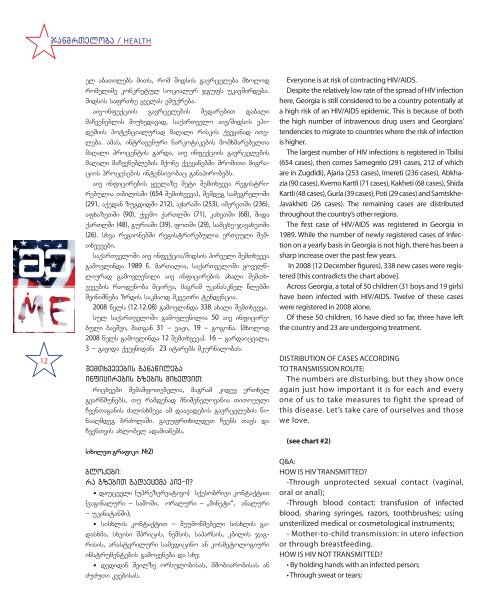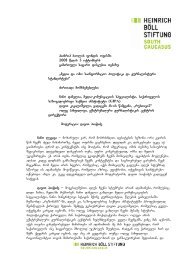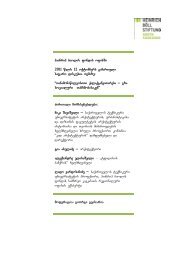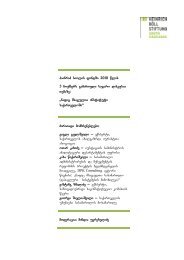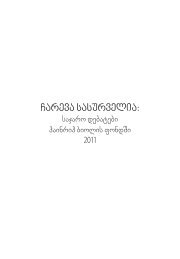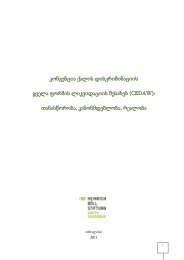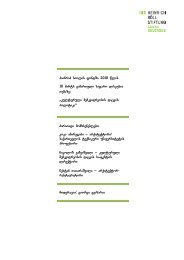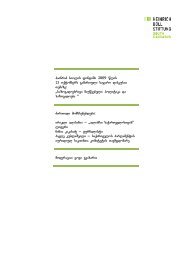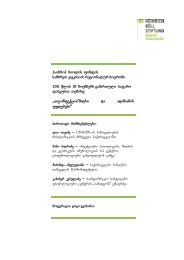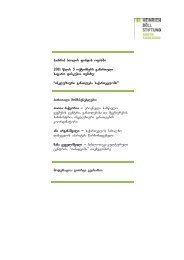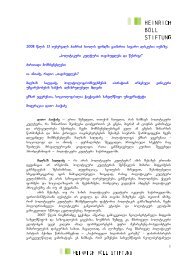HIV infection/AIDS”, posed a terrible threat to humankind. The panic
HIV infection/AIDS”, posed a terrible threat to humankind. The panic
HIV infection/AIDS”, posed a terrible threat to humankind. The panic
You also want an ePaper? Increase the reach of your titles
YUMPU automatically turns print PDFs into web optimized ePapers that Google loves.
12<br />
janmrTeloba / HEALTH<br />
el abaTilebs miTs, rom Sidsis gavrceleba mxolod<br />
romelime konkretul socialur jgufs ukavSirdeba.<br />
Sidsis safrTxe yvelas emuqreba.<br />
aiv-infeqciis gavrcelebis SedarebiT dabali<br />
maCveneblis miuxedavad, saqarTvelo aiv/Sidsis epidemiis<br />
potencialurad maRali riskis qveyanad iTvleba.<br />
amas, intravenuri narkotikebis momxmarebelTa<br />
maRali procentis garda, aiv infeqciis gavrcelebis<br />
maRali maCveneblebis mqone qveyanebSi SromiTi migraciis<br />
procesebis intensivobac ganapirobebs.<br />
aiv inficirebis yvelaze meti SemTxveva registrirebulia<br />
TbilisSi (654 SemTxveva), Semdeg samegreloSi<br />
(291, aqedan zugdidSi 212), aWaraSi (253), imereTSi (236),<br />
afxazeTSi (90), qvemo qarTlSi (71), kaxeTSi (68), Sida<br />
qarTlSi (48), guriaSi (39), foTSi (29), samcxe-javaxeTSi<br />
(26). sxva regionebSi registrirebulia erTeuli Sem-<br />
Txvevebi.<br />
saqarTveloSi aiv infeqcia/Sidsis pirveli SemTxveva<br />
gamovlinda 1989 w. marTalia, saqarTveloSi yovelwliurad<br />
gamovlenili aiv inficirebis axali SemTxvevebis<br />
raodenoba mcirea, magram ukanasknel wlebSi<br />
SeiniSneba zrdis sakmaod mkveTri tendencia.<br />
2008 wels (12.12.08) gamovlinda 338 axali SemTxveva.<br />
sul saqarTveloSi gamovlenilia 50 aiv inficirebuli<br />
bavSvi, maTgan 31 _ vaJi, 19 _ gogona. (mxolod<br />
2008 wels gamovlinda 12 SemTxveva). 16 _ gardaicvala,<br />
3 _ gavida qveynidan; 23 itarebs mkurnalobas.<br />
SemTxvevebis ganawileba<br />
inficirebis gzebis mixedviT:<br />
ricxvebi SemaSfoTebelia, magram kidev erTxel<br />
gvarwmunebs, Tu ramdenad mniSvnelovania TiToeuli<br />
CvenTaganis Zalisxmeva am daavadebis gavrcelebis winaaRmdeg<br />
brZolaSi. gavufrTxildeT Cvens Tavs da<br />
CvenTvis axlobel adamianebs.<br />
(ixileT grafiki #2)<br />
blokebi:<br />
ra gzebiT gadaecema aiv-i?<br />
• daucveli (uprezervativo) sqesobrivi kontaqtiT<br />
(vaginaluri _ saSoSi, oraluri _ `mineti~, analuri<br />
_ ukanatanSi);<br />
• sisxlis kontaqtiT _ Seumowmebeli sisxlis gadasxma,<br />
sxvisi Spricis, nemsis, saparsis, kbilis jagrisis,<br />
arasteriluri samedicino an kosme<strong>to</strong>logiuri<br />
instrumentebis gamoyeneba da sxv;<br />
• dedidan Svilze orsulobisas, mSobiarobisas an<br />
ZuZuTi kvebisas.<br />
Everyone is at risk of contracting <strong>HIV</strong>/AIDS.<br />
Despite the relatively low rate of the spread of <strong>HIV</strong> <strong>infection</strong><br />
here, Georgia is still considered <strong>to</strong> be a country potentially at<br />
a high risk of an <strong>HIV</strong>/AIDS epidemic. This is because of both<br />
the high number of intravenous drug users and Georgians’<br />
tendencies <strong>to</strong> migrate <strong>to</strong> countries where the risk of <strong>infection</strong><br />
is higher.<br />
<strong>The</strong> largest number of <strong>HIV</strong> <strong>infection</strong>s is registered in Tbilisi<br />
(654 cases), then comes Samegrelo (291 cases, 212 of which<br />
are in Zugdidi), Ajaria (253 cases), Imereti (236 cases), Abkhazia<br />
(90 cases), Kvemo Kartli (71 cases), Kakheti (68 cases), Shida<br />
Kartli (48 cases), Guria (39 cases), Poti (29 cases) and Samtskhe-<br />
Javakheti (26 cases). <strong>The</strong> remaining cases are distributed<br />
throughout the country’s other regions.<br />
<strong>The</strong> fi rst case of <strong>HIV</strong>/AIDS was registered in Georgia in<br />
1989. While the number of newly registered cases of <strong>infection</strong><br />
on a yearly basis in Georgia is not high, there has been a<br />
sharp increase over the past few years.<br />
In 2008 (12 December fi gures), 338 new cases were registered<br />
[this contradicts the chart above].<br />
Across Georgia, a <strong>to</strong>tal of 50 children (31 boys and 19 girls)<br />
have been infected with <strong>HIV</strong>/AIDS. Twelve of these cases<br />
were registered in 2008 alone.<br />
Of these 50 children, 16 have died so far, three have left<br />
the country and 23 are undergoing treatment.<br />
DISTRIBUTION OF CASES ACCORDING<br />
TO TRANSMISSION ROUTE:<br />
<strong>The</strong> numbers are disturbing, but they show once<br />
again just how important it is for each and every<br />
one of us <strong>to</strong> take measures <strong>to</strong> fight the spread of<br />
this disease. Let’s take care of ourselves and those<br />
we love.<br />
(see chart #2)<br />
Q&A:<br />
HOW IS <strong>HIV</strong> TRANSMITTED?<br />
-Through unprotected sexual contact (vaginal,<br />
oral or anal);<br />
-Through blood contact: transfusion of infected<br />
blood, sharing syringes, razors, <strong>to</strong>othbrushes; using<br />
unsterilized medical or cosme<strong>to</strong>logical instruments;<br />
- Mother-<strong>to</strong>-child transmission: in utero <strong>infection</strong><br />
or through breastfeeding.<br />
HOW IS <strong>HIV</strong> NOT TRANSMITTED?<br />
• By holding hands with an infected person;<br />
• Through sweat or tears;


